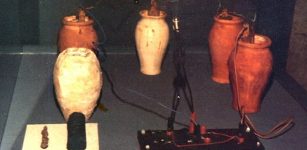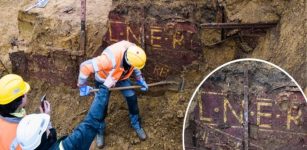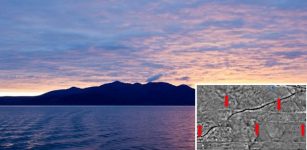Khufu Boat And Unique Boat-Building Technique Of Ancient Egyptians
A. Sutherland - AncientPages.com - More than sixty years ago, two ancient wooden boats were discovered in separate carved stone pits next to Giza's Great Pyramid in Egypt.
Until now, it is still debated over whether these boats were symbolic solar barks for the king to use in his afterlife or funeral boats used to transport Khufu’s funerary equipment to his pyramid.

Over the years, the pharaoh’s boat was variously called as the "Khufu Boat", the "Solar Barque" or simply the Pharaoh Ship
According to some Egyptologists, the ship was a Solar Barque, a boat to carry the dead king of Egypt, resurrected and floating with the Sun-god on his eternal journey across the sky. Others proposed that it was a pilgrimage boat used by Khufu during his lifetime. In fact, archaeologists who investigated the boat's remains found evidence of rope markings clearly showing that the boat had been used in the water.
Additionally, the boat did not fit into the pit whole but had to be dismantled, which means that the stone pit was not constructed specifically for the boat.

The boat did not fit into the pit whole, but had to be dismantled first, which means that the stone pit was not constructed specifically for the boat. Image source
It seems that the Khufu Boat had nothing to do with religious use; no ritual objects or inscriptions were discovered in the pit. The dismantled boat was entombed about 2500 BC.
Over the years, the pharaoh’s boat was variously called the "Khufu Boat," the "Solar Barque," or simply the Pharaoh Ship."
Experts say it is the largest ancient royal vessel ever found in Egypt and one of the oldest planked vessels in the world. It was built for Khufu (Cheops), the second pharaoh of the Fourth Dynasty of Egypt's Old Kingdom, who was the ruler of Upper and Lower Egypt around the middle of the third millennium BC.
The earliest representations of Egyptian Nile vessels were only very simple images that date back to 4500 BC.
An important and sensational discovery came in 1991.
Researchers led by David O’Connor, then assistant curator of Egyptology at the museum of the University of Pennsylvania, discovered in the ancient city of Abydos twelve parallel burials of fifty-to sixty-foot boats dating to Dynasty I or II, that is roughly one thousand years before the Khufu Boat.
The team unearthed one of the boats, which gave evidence of an ancient Egyptian boat-building.
Interestingly, "the Abydos boats were likely used rather than built only as funerary vehicles…. They were also “sewn” like the construction of the thousand-year-later Khufu Boat…” (Gordon S. A History of the World in Sixteen Shipwrecks).
Returning to the Khufu Boat, we learn that after 13 years of painstaking reconstruction works, as many as 1224 pieces of the ship were assembled together. The boat, built of cedar trees from the mountains of Lebanon, is forty-five meters long from stem to stern and 5.9 m (19.5 ft) wide.
As a part of grave goods intended for use in the afterlife, the Khufu Boat contained no bodies, unlike northern European ship burials, for example, those of the Vikings. The Viking chiefs who held high status were given ship burial and were either burned or buried along with their ship.
Ancient Egyptians had a long boat-building tradition, but they used different techniques than the Vikings, who nailed their ships together with iron nails. The Khufu Boat and other Egyptian boats were not nailed.
Along with the puzzle-piece joggling, its builders connected neighboring planks with mortise-and-tenon joints, a kind of peg-in-hole technique. They also lashed the hull planks together with rope made from a grass called halfa. They didn't wrap the rope around or through the hull planks, which might have promoted leaks. Rather, they worked it through thousands of V-shaped channels they laboriously carved into the inside faces of planks.
It was their unique, at least 4,500 -year-long technique to build a ship. They sewed the ship together.
Written by – A. Sutherland AncientPages.com Staff Writer
Copyright © AncientPages.com All rights reserved. This material may not be published, broadcast, rewritten or redistributed in whole or part without the express written permission of AncientPages.com
Expand for referencesGordon S. A History of the World in Sixteen Shipwrecks
More From Ancient Pages
-
 Atlatl Weapon Use By Prehistoric Females Equalized The Division Of Labor While Hunting – Study Shows
Archaeology | Aug 18, 2023
Atlatl Weapon Use By Prehistoric Females Equalized The Division Of Labor While Hunting – Study Shows
Archaeology | Aug 18, 2023 -
 Was Prehistoric Baghdad Battery A Unique Find Of The Ancients? – Did Its Manufacturers Discover Electricity By Accident?
Ancient Technology | Mar 8, 2019
Was Prehistoric Baghdad Battery A Unique Find Of The Ancients? – Did Its Manufacturers Discover Electricity By Accident?
Ancient Technology | Mar 8, 2019 -
 Ancient Wall Of Lolei Temple Built In 893 BC Unearthed In Siem Reap, Cambodia
Archaeology | Apr 20, 2020
Ancient Wall Of Lolei Temple Built In 893 BC Unearthed In Siem Reap, Cambodia
Archaeology | Apr 20, 2020 -
 Mystery Of Vitrified Scottish Fort Dun Deardail And Ancient Myth Deirdre Of The Sorrows: Is There A Prehistoric Connection?
Civilizations | Feb 5, 2021
Mystery Of Vitrified Scottish Fort Dun Deardail And Ancient Myth Deirdre Of The Sorrows: Is There A Prehistoric Connection?
Civilizations | Feb 5, 2021 -
 Exceptionally Long-Lived Ancient Form Of Hydraulic Engineering Unearthed In The Nile Valley
Archaeology | Jun 13, 2023
Exceptionally Long-Lived Ancient Form Of Hydraulic Engineering Unearthed In The Nile Valley
Archaeology | Jun 13, 2023 -
 Shining Ones, Archimedes Death Ray And Mystery Of Vitrified Forts In Scotland
Ancient Technology | May 13, 2015
Shining Ones, Archimedes Death Ray And Mystery Of Vitrified Forts In Scotland
Ancient Technology | May 13, 2015 -
 How Did The Early Rapa Nui People Put Huge Hats On Giant Statues Of Easter Island?
Ancient Technology | Jun 5, 2018
How Did The Early Rapa Nui People Put Huge Hats On Giant Statues Of Easter Island?
Ancient Technology | Jun 5, 2018 -
 Two Scribes Penned 8th Century ‘Samaria Ostraca’ Inscriptions Unearthed In Samaria
Archaeology | Jan 23, 2020
Two Scribes Penned 8th Century ‘Samaria Ostraca’ Inscriptions Unearthed In Samaria
Archaeology | Jan 23, 2020 -
 Rare Roman Mosaic Of Amazon Warriors Unearthed In Syria Hailed As Major Archaeological Discovery
Archaeology | Oct 12, 2022
Rare Roman Mosaic Of Amazon Warriors Unearthed In Syria Hailed As Major Archaeological Discovery
Archaeology | Oct 12, 2022 -
 Hispano-Visigothic Grave At Ojo Guareña – Resting Place Of A Hermit Who Sought Isolation When The Moors Arrived?
Archaeology | Sep 17, 2021
Hispano-Visigothic Grave At Ojo Guareña – Resting Place Of A Hermit Who Sought Isolation When The Moors Arrived?
Archaeology | Sep 17, 2021 -
 Mysterious Ancient Stone Structure Discovered In Torreano, Italy
Archaeology | Mar 29, 2023
Mysterious Ancient Stone Structure Discovered In Torreano, Italy
Archaeology | Mar 29, 2023 -
 New Insight On What Ancient Noses Smelled
Archaeology | Mar 29, 2023
New Insight On What Ancient Noses Smelled
Archaeology | Mar 29, 2023 -
 Gigantic Kailasa Temple: Engineering Marvel Of India’s Master Builders
Featured Stories | Oct 17, 2020
Gigantic Kailasa Temple: Engineering Marvel Of India’s Master Builders
Featured Stories | Oct 17, 2020 -
 Utnapishtim And The Babylonian Flood Story
Featured Stories | Jan 28, 2016
Utnapishtim And The Babylonian Flood Story
Featured Stories | Jan 28, 2016 -
 Igaluk – Powerful Eskimo Moon God That Directs Natural Phenomena
Featured Stories | Feb 13, 2019
Igaluk – Powerful Eskimo Moon God That Directs Natural Phenomena
Featured Stories | Feb 13, 2019 -
 The Mixtec – Mysterious Very Advanced Culture Of The Foremost Goldsmiths Of Mesoamerica
Civilizations | Dec 2, 2017
The Mixtec – Mysterious Very Advanced Culture Of The Foremost Goldsmiths Of Mesoamerica
Civilizations | Dec 2, 2017 -
 Mysterious Railway Car Discovered Under An Old Fortress In Antwerp, Belgium
Archaeology | Apr 12, 2024
Mysterious Railway Car Discovered Under An Old Fortress In Antwerp, Belgium
Archaeology | Apr 12, 2024 -
 Never-Before-Seen 5,000-Year-Old Mysterious Monument On Isle Of Arran Discovered By LIDAR
Archaeology | Jan 27, 2021
Never-Before-Seen 5,000-Year-Old Mysterious Monument On Isle Of Arran Discovered By LIDAR
Archaeology | Jan 27, 2021 -
 What Was The Agriculture Like In Southeast China In The Late Neolithic?
Archaeology | Apr 11, 2022
What Was The Agriculture Like In Southeast China In The Late Neolithic?
Archaeology | Apr 11, 2022 -
 Impressive Study Highlights Female-Led Migration Into Bronze Age Orkney And Wins Prestigious Award For 2023
Archaeology | Apr 4, 2023
Impressive Study Highlights Female-Led Migration Into Bronze Age Orkney And Wins Prestigious Award For 2023
Archaeology | Apr 4, 2023


